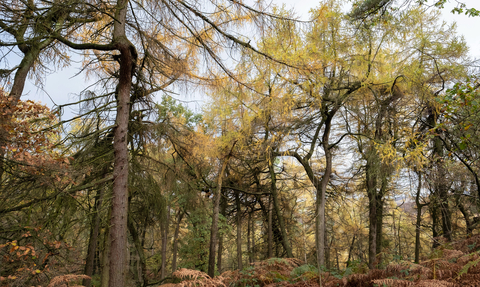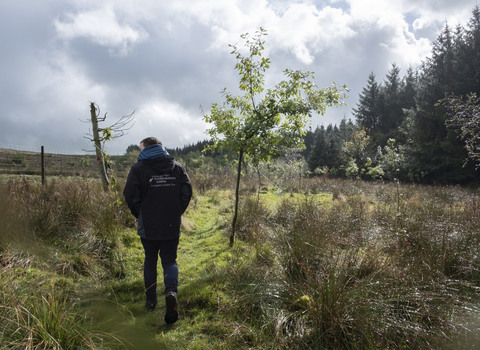
Back Forest by CN Harding
Winter work at The Roaches
Larch disease
Throughout the winter (2024/25) we will sadly be continuing our work to fell larch trees in Back Forest (not far from Gradbach Scout camp) at The Roaches Nature Reserve. Some of these trees are close to footpaths, so we will need to close sections off while the work takes place. Signage will be in place and visitors will be redirected or asked to wait until it's safe to pass when working is taking place. We began this work last year, and will continue it during January - it will take place on weekdays. The lower path will be closed (same as during the 23/24 felling) and the top path will have temporary closures in place.
We hope to have the work completed by the end of January but this is very much weather dependent.
Why are we doing this?
Unfortunately, we have to remove a large number of larch trees in this area after being issued with a statutory plant health notice by the Forestry Commission. This means the Trust is legally required to fell the trees, because they have a disease called Phytophthora ramorum. In larch, the disease progresses very quickly, killing trees which makes them very weak and liable to fall.
While visiting, please observe any signage and path diversions for safety.
What is Phytophthora ramorum?
Phytophthora ramorum is an algae like organism called a water mould. It causes extensive damage and death to infected trees. Larch trees, which were widely planted for the timber market, are known to be particularly susceptible, and large numbers have been affected across the UK and beyond. Phytophthora ramorum does not just affect Larch. It can also affect European sweet chestnut and horse chestnut. Other conifer species such as douglas fir, grand fir, noble fir and western hemlock can be infected when growing near infected larch. It has also been confirmed in a small numer of sitka spruce (information from Forest Council and can be read here: www.forestresearch.gov.uk/tools-and-resources/fthr/pest-and-disease-resources/ramorum-disease-phytophthora-ramorum
Phytophthora ramorum spores spread via wind-driven rain. When they land on a leaf they grow into the tree by breaking down the cell walls in the leaf. This leads to the initial blackening symptoms. It then grows within the tree and blocks its water transport system leading to dieback and eventual death. While this process is happening, the pathogen will also be spreading onto other nearby trees and shrubs.
How many trees will be felled?
We anticipate it will be hundreds, as well as felling infected trees, we must also fell any other larch within 200 metres of an infected tree. We are legally required to do this, due to the diseases ability to spread rapidly to nearby trees. Thankfully, Back Forest has lots of native trees too. This will mean we still have a forest; it will just be a little sparser.
Will new trees be planted?
We’ll be working with the Forestry Commission to draw up a restoration plan for the area. We hope we can restock with native hardwoods, which will complement the existing woodland. New trees would include species such as oak, hazel and birch (pictured below).
Other work at The Roaches
During winter 2023 we also installed a timber fence around Doxey Pool, which sits not to far from the trig point. We worked under Natural England consent to fence around the pool, to improve the water quality and reduce the erosion around the pool edges. Eventually this work will allow the pool edge to revegetate, and provide quality habitat for wildlife to move back in.
The ecological condition of the pool is very poor and we had to act to turn things around. It had no wildlife, yet it should support various peatland invertebrates and plants. The water quality could never have recovered while the pool continued to be used by passing dogs (sometimes people too). Wildlife needs both to stop. While we understand why people might encourage their dogs into the pool, we have to put wildlife first. Each year thousands of dogs (and people) enter the pool causing erosion to the banks, disturbing the floor of the pool, and adding harmful chemicals from flea treatments and shampoo to the water.
The images below show how it looked before the work, and how we hope it will look in time – the last two photos show Mermaid Pool (also called Bake Mere), which is not to far away (not managed by SWT). This is the only other tarn in Staffordshire.
We hope visitors will be understanding and work with us to turn this pool into a wildlife haven; please respect the fence and keep dogs out. Let’s work together to give wildlife a chance to benefit from this wild pool.

Christine Harding
Explore our reserves
We care for over 40 nature reserves spanning over 1,900 hectares. Head to our reserves page to find out more about these special places.







